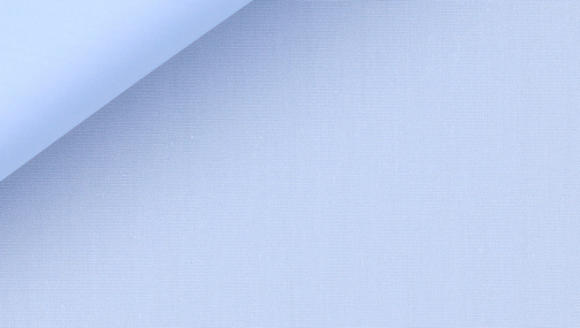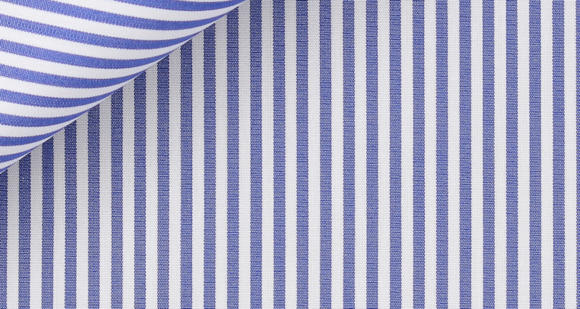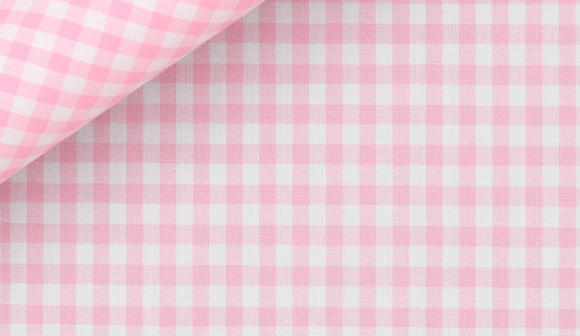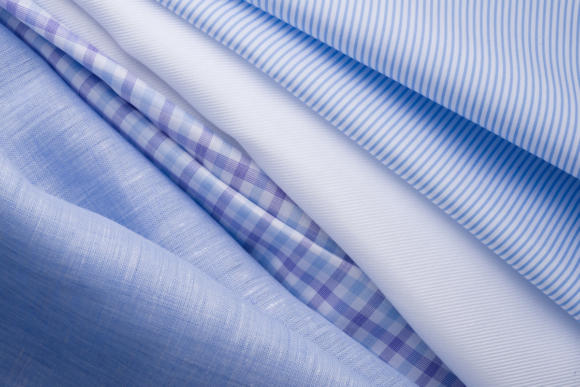Even with increasingly dressed-down work environments, most bespoke shirts are made for professional, business use.
They need to look smart therefore: crisp and sharp, and smooth without being shiny.
They will generally be in muted tones of white, blue and (occasionally) pink. Any pattern will be small and discreet.
Given they are intended for frequent use, the fabric also needs to be hard wearing. Something that can be worn once or twice a week for months without fraying, and perhaps even treated to reduce ironing.
So which fabrics meet all these criteria?
Weave structure
The default weave for a business shirt is usually poplin (above). It’s crisp and smart, and similar plain weaves like Zephir are very lightweight and breathable.
A twill will wrinkle less, however. It’s heavier than poplin, but if creasing is an issue, then it might be preferable.
Oxford fabrics are popular in the US, but in general are less professional. At the very least, the oxford should be smooth and fine – or a smarter variation on the oxford, such as pinpoint.
The least suitable fabrics are those with the most texture, such as linen or brushed cotton.
Fineness
As with suits, there is a tendency for certain, flashier businessmen to pick very fine shirt fabrics. They are rarer, more expensive, and something to talk about.
But while fabrics with such high yarn counts (140 to 300+) feel silky and nice against the skin, they do tend to crease faster.
A more normal shirting, say 2/100, will still look good, wrinkle less, and last longer. Certain English shirt makers used to refer to 100-count as the gold standard for shirts: a solid, safe investment.
If you want something a touch silkier, perhaps opt for 2/120; if a touch more hard-wearing, 2/80. It depends on the priorities.
And of course a twill in either will wrinkle less than poplin.
(The ‘2′ in 2/80, by the way, refers to the yarn being two fold or two ply, and is pretty standard on quality shirts.)
Colours and patterns
While plain-white and plain-blue shirts will always be most popular for business, how much colour and pattern is appropriate will be down to the particular office.
Plains and hairline stripes will be largely anonymous. Bolder patterns, such as a butcher’s stripe, introduce a little more character, as do colours like pink and yellow.
Checks are generally more casual than stripes. But again, depending on the office, a pink gingham check (above) might be perfectly acceptable.
As with oxford cloths in the US, it’s also worth remembering that part of this is cultural.
The British have a particular tradition for bold shirts, originating from the limitations of being only able to wear a club or regimental tie, and therefore experimenting with the fabric underneath. Even today, a pink shirt tends to be more acceptable in the UK than in the US.
Treatments
As mentioned, fabrics with lower yarn counts, and in weaves like twill, will always be harder wearing and easier to iron.
Beyond these options, shirts can also be treated with particular finishes.
Some ‘non-iron’ shirts are simply mixes of cotton and polyester. These should generally be avoided, as they tend to feel harder, are not as breathable, and hang onto odours.
Good treatments will coat a fabric, stopping the fibres absorbing water when they’re being washed (Thomas Mason’s ‘Journey’ is a good example).
This keeps the shirt fairly sleek, with some twills being OK with no ironing at all, and poplins requiring just a quick press.
The only downsides are that the fabric can feel a little dry (though that is greatly reduced in newer versions) and the treatment will eventually wash out. This tends to only be after 40 washes at a minimum, however.
































Thanks for all this Simon. I know far below your normal radar but would be interesting to hear your thoughts on the standard business shirt providers (TM Lewin, Charles T, Harvie & Hudson etc) where you can get a good deal and buy shirts more in bulk. Even if by word of mouth would be useful
In general, those volume makers provide good value for money. The fabrics are never as good, but if you pick something hard wearing and care less about fineness, they can be good workhorses
Would be good to hear your thoughts on Matt’s point about Harvie Hudson .
After all most of us want long lasting , good quality , well fitted work horse shirts .
I can’t say much I’m afraid – I’ve never tried them myself
Key point is that T M Lewin in particular gets the collars and cuffs right with proper ‘fullness’ at a near department store price point. Don’t underestimate how important this is to looking right – most shirts fail you here.
Interesting, thanks Philip. What do you mean by fullness exactly? The structure of them, or their size?
Structure. Shirts from the original Jermyn Street makers (even those that are now mail order companies with a retail presence) have a ‘fullness’ or ‘plumpness’ to the collar which I just don’t see in shirts from elsewhere. There appear to be two components, the first is use of a thick soft interlining and the second it seems is tension on the yarn used to sew the collar stitch line as the effect is that the stitching seems indented into the softness of the collar, giving it a ‘full’ look. To me this is the hallmark of a Jermyn St shirt and a ‘proper’ collar. I have looked at shirts made elsewhere and the collars are thin with the stitching on the surface. To me they just don’t look ‘right’.
The T&A factory footage here is worth watching – key point: “collars are an art” , and that is exactly it. Jermyn Street collar seems very difficult to reproduce.
https://youtu.be/FSw8cznC788?t=213
Note how they are using what I would call ‘jigs’. I would guess that T.M Lewin shirts are no longer made by “little old ladies in Leigh on Sea” as they once were, but maybe the jigs and some of the expertise were transferable to wherever they are now made.
Thanks Philip. I’d imagine a big difference will also be whether the lining is ‘floating’ or as most European ones are, fused
Harvie & Hudson offer slightly better quality than the ‘4 shirts for £100’ brigade (Lewin, Tyrwhitt, H&C). However, the down-sides are that they’re slightly more expensive, offer fewer shirts with a button cuff and usually require some form of alteration to accommodate for their overly-generous cut (admittedly, the last two are entirely subjective and may be viewed as positives by podgy cuff-link obsessives!)
For what it’s worth, I buy “nice” shirts (T&A etc) for out of work, but stick to white Charles T for work.
It may sound naff (after all, I’m wearing a nice suit, and want to look smart) but the shirts just get absolutely destroyed on the commute. Cuff stains that won’t come out, more than one tear from a door. My commute just doesn’t warrant shirts that cost any more.
Of them all, I find the Charles T to be the best white work shirts, and (if you want non-iron casual) then the brooks brothers ones dry well enough to need no ironing at all.
I’d concur on that point Charles – it’s the easiest thing to save money on in that outfit, definitely. Particularly if you get a good fit, or even have them altered a tiny bit to fit well.
For the morning commute I used to wear Boden shirts. They are pretty rugged and have a few collar styles which don’t collapse if you are tieless.
Excellent information, thank you. As an aside, I would encourage your readers to consider adding pink shirts, solid and pattern, to their wardrobe. The color works well with just about any skin tone and they will get compliments, mostly from women.
Thank you for this Simon.
Any thoughts on summer versus winter materials? I currently work in New York and whilst offices are, of course, air-conditioned the commute can be hellishly warm. Would a linen-cotton mix be an improvement on pure cotton?
Yes it would, and a nice option. Lightweight weaves like zephyr are also nice, and a bit smarter
hi Mr. Simon,
for a summer wedding outfit. what kind of shirt complement a dark brown suit? and also what kind of shoes? the wedding will still be held indoor, but with a more casual setting.
A nice formal combination with a dark brown suit would be a white shirt and grey tie, perhaps, with black shoes. See example here.
Will you please identify the make and style number of all the fabrics in the photo for this article; they are all fantastic.
Sure, I’ll get them now.
They are:
FM33268-1172 BYRON KENT (poplin) – book Thomas Mason Bespoke
FM33333-17 SILVER (poplin) – book Thomas Mason Bespoke
FM20564-31 ZEPHIR 1818 (zephyr) – book Thomas Mason Bespoke
Various fabrics from the Journey range by Thomas Mason
Hi Simon,
Slightly geeky question, but is there ever a need to fuss over collar stiffeners with business shirts?
I have a large collection of these from both RTW and bespoke makers (mostly plastic) that I throw in a pot after each day – but there is a range in flexibility.
I normally just pick out two of the same each morning but wondering if it’s best to use the more rigid stiffeners for business shirts??
I think it’s just a question of the effect Neil. If the collar looks sharp enough and isnt curling up, then pick the one that does that and is the most comfortable, or least visible (stiffer ones can be quite prominent)
I’m curious to how you’d place off-white, cream or ecru shirts these days. Most ready-to-wear shirtmakers on Jermyn Street stock those alongside white and blue. Are they outdated now?
Unfortunately they probably are, yes. If the colour was noticeable, they would be so unusual that someone might even think it was just a discoloured white one
As an Englishman living in the US for the past six years, I agree with the sentiment on US shirt culture and Oxford cloths. I have tried to purchase the best quality American cotton and manufactured Oxford cloths and although the body of the shirts hold their shape reasonably well, the collars lack the structure and shape in contrast to other weaves.
Well that’s the point of a classic such as the Brooks Brothers oxford cloth button down – much of the appeal is in the soft roll of the collar. Whether it should be worn with a suit and tie is a matter of taste (as Simon said pinpoint oxford being the more acceptable), but among the preppy set it’s a go to; sort of the “I’d rather be at the country club” mindset of Vineyard Vines’ ties or loafers worn with a suit.
Dark Brown suit with white shirt !
Firstly dark brown, as a wedding suit , YOUR GETTING MARRIED, not attending the Cheltenham Festival. !!! If you insist in inflicting your partner with brown, cream shirt, soft gold tie
Hi Simon, do you have a preference for Thomas Mason fabrics or are there additional suppliers you like. Best KK
I like and use many suppliers, the images just happen to be from Thomas Mason
Hi Simon,
I’ve been looking for non-wrinkle / non-iron shirts for a while. The best I found are Eton (twill fabric). Do you have any thoughts on that and recommendations for others?
Thanks.
I’m afraid I haven’t tried any, so no I can’t recommend any, sorry
The French prefer solid white. New York and Wash DC business people tend towards solid white and blue with occasional stripes. UK businessmen the most adventuresome with colours and patterns.
Re. oxford cloth there is a crisper finer version called royal oxford which makes for an excellent business shirt with a slightly heavier weight (than poplin) for winter. Pinpoint, end-on-end and particularly herringbone are also worthy of consideration. My favourite, especially for summer, is a lightweight marcella or pique cloth. For SMA…Eton are good but I found that the collars wear more quickly than other options – you could also try Olymp or Eterna for cotton non-iron/easy wear shirts.
I do beg to differ on cream shirtings. These are really a much more attractive, and in my entirely subjective opinion, more stylish option than plain white. White can make many of us pale people look even more grey and ashen. It is also rather old school IBM or “salary man” from Japan. This is why serious English shirt makers like Budd or Emma Willis tend to stock cream not only in cotton but in silk. Cream is more subtle, less “managerial” and goes better with both city suits and tweeds. I appreciate that de gustibus non est disputandem.
Hi Simon,
I didn’t realise that treated shirts were available in good quality fabrics, I always assumed they had some man-made fibres in them. I will have to take a closer at the Thomas Mason journey fabrics next time Luca is in town, as someone who travels a lot, reducing creasing is a major benefit. I don’t suppose there are any stain resistant coatings available (travelling a lot to hot countries tends to wear shirts pretty quickly)?
Explaining cloth still remains one of the missing pieces of the whole bespoke industry to me and I really appreciate your efforts. Unless one has the time and inclination to go around the various cloth merchants or mills, or attends the trade shows I think it is impossible to get this info comprehensively though a tailor – a get little bits of information on the cloths they have discovered but never the full picture. Your efforts are incredibly helpful.
Best
Rob
Thanks Rob, I’m really pleased. Let me know what you think of the series going through all the available bunches too – we did one on the seasonal Italian bunches and will do one soon on linen.
No, I don’t know any stain resistant treatments I’m afraid
Apologies for being slightly off topic…
Any chance you could do a piece on hand-washing shirts at home and more importantly, a high level guide to ironing formal shirts at home? I really enjoy the process and it works pretty well for me but I can’t find a PStyle level guide on it anywhere. Do you have any insight into what the pros in Napoli do with their shirts at home? What would Fiorenzo Auricchio do? Thanks.
Thanks, yes we have one planned as part of our video series… Wont be long
Can’t wait! Outside of dogs on Instagram you remain just about as good as the internet gets.
Thanks.
My aim is to be even better than the dogs
What brand and model of iron and ironing board do you use?
It’s Bosch I think – but I wouldn’t worry too much about these. Care and accuracy of use will matter far more than power
Hi Simon,
As we are going into colder weather, what are your thoughts on warmer business dress shirt fabrics?
Would you be able to pull off a plain, light blue or white flannel dress shirt as a substitute for poplin?
Not for a business shirt, no.
In general I might wear heavier casual shirts when it’s colder, but not business ones
I see – thanks for sharing.
Best,
Bernie
Hi Simon,
Long time reader, first time poster. I have two questions for you regarding shirt cloth if I may:
1, I have always tried to have the whitest shirts possible, because a QC I once worked with (who unfortunately passed away) had such impressively white shirts, and I have wanted to emulate him. However, despite my efforts (soaking, Napisan, etc) I have not quite satiated my standards… any thoughts on the ultimate white shirt?
2, I live in australia, and plainly have to deal with some pretty extreme temperatures from time to time. I’ve noticed that some shirts will show up sweat much worse than others – any thoughts as to why? I only have poplin business shirts, so presume it is more to do with the quality of the different shirts?
Many thanks for your superb site
Thank you.
On whiteness, it would usually be down to the type of fabric (twill, poplin, light, heavy) and slightly more to how they are looked after – eg washing just whites on their own.
On sweat, if they’re all the same fabric, I’d imagine it might be to do with how they’re cut, eg closer to the armpit. There’s not much in the quality that would make them sweat more, unless they’re not all 100 per cent cotton. Indeed, finer shirts are often denser and less breathable
Hi Simon, in a MTM shirt is possible also personalised the lenght of the collar or is in standard size?
Hi Lorenzo,
Usually with an MTM shirt the maker will ask you to pick from a set of collar shapes. Indeed this can be the case with the bespoke as well – at the very least, the shapes are used as a starting point with bespoke, before adjusting them.
MTM isn’t always that consistent though – occasionally a maker will say they can change a collar shape. It’s always worth asking.
I hope that’s helpful
Simon
Does it make a big difference or is it just marginal whether one wears a twill or a popelin shirt in summer assuming both have the same fineness?
It depends on how hot the summer gets, and how hot you get generally, but I would notice a difference in the summer with a twill, yes
Thank you Simon. Would you say oxford fabrics crease more/less compared to a poplin or twill with the same fineness?
Generally poplin will crease a little more than the others, but it’s more dependent on the yarn than the weave
Would you say this oxford is smooth/fine enough to wear with a business suit?
I’ve never seen the shirt before, but I’m pretty sure it will be. It’s rare that shops like that ever offer really casual oxfords. They’re all pretty smart.
Hi Simon.
I recently purchased my first batch of bespoke shirts from Luca Avitabile.
I opted for four all white cotton shirts for work and threw in a chambray/denim shirt for casual wear.
The fit is fantastic but one issue (the only issue) I am having is that the white cotton shirts crease incredibly easily once being worn.
Do you have any suggestions to prevent this? Starching perhaps?
Best,
John
Hi John,
I don’t I’m afraid. It sounds like perhaps they were finer cottons, which often feel lovely but will crease more.
Hi Simon, I am so bored by these business fabrics. With ties no longer around in everyday office live, I feel somewhat disgusted by my own white/blue business shirt and grey/navy suit outfits. Do you have any idea on how one could change that? I already try to make the shirts a bit more interesting (button down, chest pocket, center box pleat, locker loop, back collar button) but this works better with more casual fabrics. So I was thinking about dressing a bit down, meaning odd trousers and OCBD in the usual colors. Any anything else one could do to escape this? Thank you so much.
If you’re getting away from the suit, there are certainly lots of ways to do it, as you can have more patterns in the jackets or shirts, there’s top and bottom to play with and harmonise